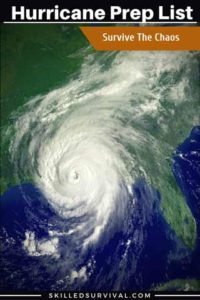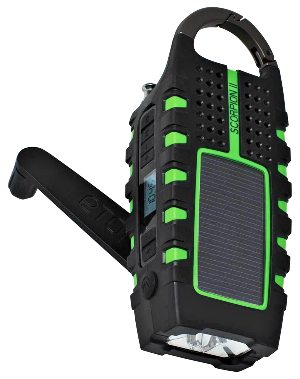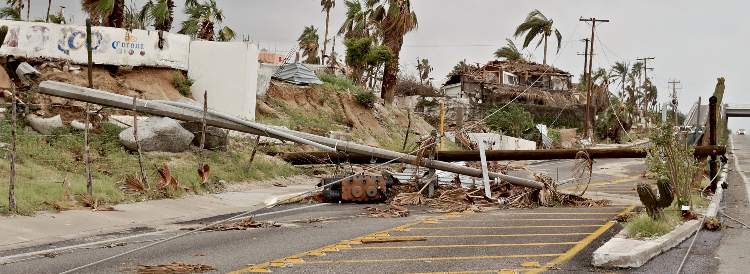A Complete Hurricane Prep List Before It Makes Landfall
Over the years, I’ve kept close tabs on the weather reports. Especially when a large tropical storm is brewing.
Sometimes, they reach hurricane status, sometimes not. But I guarantee there WILL be many hurricanes over the next few decades.
And some WILL reach landfall along the US coastline. It’s not a matter of IF but WHEN.
A Short Story Of A Hurricane Disaster
In 2005, some friends lost nearly everything to Hurricanes Katrina and Rita. Before this fateful day, these folks lived simply, building their families in a hurricane zone. Several of them were fellow coastal researchers.
Their careers were dedicated to how large storms affect the places they call home. But in 2005, several lost their homes and businesses to these massive hurricanes. And they nearly wiped their beautiful little towns completely off the map.
Years later, only half of them have returned to the Gulf. And those who did stick around have since moved to “safer” inland locations. But one common theme I noted was that few took the information seriously despite their background.
They “knew” the dangers and risks, but that was data and numbers, NOT reality… This shows the strength of human errors such as complacency and recency biases.
They hadn’t taken just how devastating it could be.
They didn’t realize an average hurricane releases as much energy in a day as the explosion of half a million small atomic bombs. And every single one of them regretted NOT creating a comprehensive hurricane preparedness list. They all failed to make time for it.
Instead, they were forced to react and became frantic as the chaotic situation unfolded. They didn’t plan, leaving them with few options and limited resources when all hell broke loose.
NOW is the time to consider your hurricane ‘preps’ and plan for the worst!
Hurricane Basics 101
“Hurricane” is the English adaptation of a word used by native languages along the US Gulf Coast. It’s a word used to describe extremely dangerous tropical storms. These types of storms develop throughout the world’s oceans. And they are known by different names (“typhoon” and “cyclone”) around the globe.
For simplicity, I’ll refer to them all as hurricanes today. And I’ll focus primarily on hurricanes in the US Gulf of Mexico and the Atlantic coast.
The storm seasons and classification schemes will vary if you live in a different part of the world. However, the core idea and recommendations for emergency planning are the same.
↓ Hurricanes 101 | National Geographic
Hurricane Season
Nearly all hurricanes that hit the mainland US are born in the tropical Atlantic. Specifically in the Caribbean Islands and the Western Shores of Africa. This is where warm ocean waters deliver tremendous amounts of moisture to rising warm air masses.
This moisture-feeding mechanism generates enormous rotating storms and draws in energy. As these storms progress across the Atlantic, they encounter the Gulf Stream. This helps to boost their energy further and tends to turn them north into the Gulf and Atlantic coasts.
This system of moisture generation depends on hot summer temperatures. So, for the South Eastern US, the storm season begins sometime in May and peaks in September. Then, it tapers off into the fall (until November) as the waters cool.
Of course, hurricanes can develop any month of the year, but they are far more likely in late summer.
Hurricane Features
“Tropical depression,” “tropical storm,” and “hurricane” are all terms describing the same thing. A rotating storm system fed by warm, moist air. The only difference in the naming is due to their size, severity, and wind speeds.
Here’s what sets a hurricane apart from tropical depressions and storms:
Hurricane Eye And Eyewall
The most distinguishing feature of a hurricane is the “eye.” The circular area of strong updraft at the center of the storm. It’s the center of the storm around which everything else rotates. Odd as it may seem, there are almost no winds at the surface within the eye.
Moreover, blue sky and visibility can commonly appear in the eye, giving it a relatively calm feel. But don’t be a fool.
The eye is surrounded by the very worst weather in the entire system. So, this is not the type of “calm” you want to experience firsthand… Surrounding the eye are towering walls of cloud banks and extreme winds.
The eyewall is like a sports stadium that raises tens of thousands of feet above sea level. This area has the most devastating winds and turbulence. It’s where measurement occurs to record wind velocity for storm classification.
Here’s a video showing some footage within the eye of a hurricane:
↓ Top 5 Hurricane Eye Walls – Incredible
Hurricane Force Winds
The storm rating system depends on the maximum observed winds (near the eyewall). But hurricanes show a dramatic decrease in wind speeds as you get further from the eye.
A Category 4 storm will have a rough “bullseye” of Category 3/2/1 winds surrounding the eye. The entire area will experience “hurricane-force winds.” However, only a small part near the eye will see sustained Category 4 level winds.
Outer Bands
Hurricanes often display long trailing “fingers” of clouds and rain. These fingers spiral away from the center for hundreds (sometimes thousands) of miles. These bands generally contain severe thunderstorms and often turn out localized tornadoes. They are home to heavy, drenching rains that often cause flooding and damage.
During Hurricane Harvey, Houston, TX, saw several FEET of rain from these outer bands. The storm stalled out over the city, giving rise to the worst flooding the city had ever seen.
Storm Surge
Sometimes, the extreme winds cause the most damage, but often, it’s the flooding. Hurricanes dump copious amounts of rainfall and bring a surge of water to shore. The sustained winds from the hurricane create a water-stacking effect.
Ocean water becomes pushed together into a massive heap out at sea. But when this bulge of seawater reaches land, it easily spills over sea walls, damns, and barriers. This often causes extreme flooding damage to buildings and residencies along the coast. Especially in low-lying areas (such as vast areas of New Orleans…) And the storm surge often occurs BEFORE the hurricane makes landfall!
So coastal flooding can make evacuation difficult, if not impossible. I recommend everyone take a few minutes to watch this excellent video on storm surges:
↓ Why A Storm Surge Can Be The Deadliest Part Of A Hurricane
Hurricane Categories
Authorities categorize hurricanes by the Safir-Simpson scale. This scale is based on the “maximum sustained winds.”
These are CONSTANT wind speeds – gusts can be considerably higher in each category!
- Winds below 74mph = Tropical Storm
- 74 to 95mph Winds = Category 1 Hurricane
- 96 to 110mph Winds = Category 2 Hurricane
- 111 to 129mph Winds = Category 3 Hurricane
- 130 to 156mph Winds = Category 4 Hurricane
- Winds above 157mph = Category 5 Hurricane
Want to see a detailed visual of the damage caused by different windspeeds? Watch this video:
↓ Why Hurricane Categories Make A Difference
Hurricane Predictions
Hurricane predictions on the weather report generally depend on understanding three terms:
1. Hurricane Watch
A “Hurricane Watch” means you should expect hurricane conditions within 48 hours. At this stage, you should be:
- Reviewing your hurricane prep list and plan
- Staying up to date on the weather forecast
If authorities upgrade a hurricane from a watch to a warning – be ready to act immediately.
2. Hurricane Warning
A “Hurricane Warning” means you can expect hurricane conditions in the next 36 hours. During a hurricane warning, you should:
- Complete all remaining preparations and
- Be ready to evacuate if ordered to do so
3. Cone Of Uncertainty
The cone of uncertainty is a new tool in hurricane forecasting. It gives meteorologists a way to show a hurricane’s most likely future path of travel. Meteorologists run thousands of storm trials.
These trials help them understand the variability in how a storm develops and moves. They then use statistics to give them the best guess of where a storm will travel and hit. But as we all know, predictions are more accurate for shorter time scales than long-term.
So, the predicted path starts to narrow at the current location. The closer the predicted path is to its current location, the smaller the cone of uncertainty is. So, the predicted path over the next few hours is pretty much guaranteed.
The cone gets wider as the path gets further out in time. This provides a wider range of possible paths given by the model variations.
↓ The Basics Of Hurricanes and Tropical Weather Forecasting
Now let’s get into your list – we’ll cover action items before, during, and after… Here’s a comprehensive overview video if you’d rather get your information that way:
↓ How To Prepare For A Hurricane (Before, During, After)
How To Prepare BEFORE A Hurricane
First, take a lesson from my friend’s misfortune and plan ahead! Don’t wait until the storm has nearly arrived to take precautions.
By then, you’ve limited your options, which is a fragile position to be in if you want to live a resilient life – the more options you have, the better! The main options are critical supplies and possible courses of action. Preparing early improves your survival chances with less stress, damage, and injury!
Plan Your Evacuation Route Early
As your location enters the cone of uncertainty, authorities will issue an evacuation. Never wait for someone to tell you how to get to safety or follow a blind herd of humanity.
Instead, research the best evacuation routes from your area beforehand. Then, when the time comes, you’ll be able to navigate safely with less confusion, worry, and traffic. This means establishing an emergency meetup location with family and friends to await the storm.
A place where you can get gas and supplies, what shelters will be available, and where you can go with pets. Practicing the route to see all the details in person is wise.
Stock Up On Non-Perishable Supplies Early
Once authorities issue a hurricane watch or warning, critical supplies go fast. The news always shows footage of empty store shelves and long lines at the gas station. For items with a long shelf life, it pays to stock up early to avoid wasting time in long lines.
Plus, supply and demand kick in when supplies run short, and you pay premium prices…
Instead, it’s better to accumulate supplies and resources between hurricane seasons, if possible.

Also, be sure to keep these items organized and accessible. You’ll want to take some of them with you during an evacuation. Here’s a simple list of items you should include:
- Batteries
- Non-perishable canned foods and freeze-dried foods (don’t forget the pets)
- EDC flashlights, tactical flashlights, and solar lanterns
- Matches
- Drinking water
- Emergency home repair supplies (tarps, plastic sheeting, plywood, tools)
- First aid kits and medical kits
- Prescription medications
- Personal toiletries
- Important documents
- Extra clothing and footwear
- Ammunition (stored in ammo cans)
- A portable hand-crank NOAA weather radio
Inventory Your Property
Once the storm is over, you must have documentation for any insurance claims. And meticulous inventory is a lifesaver when dealing with evil insurance adjusters.
A paper version is better than nothing, but I recommend walking through the house as you take the video. Nearly everyone has a smartphone nowadays – so it’s simple to do this and may only take 20 minutes. So, no excuses – do it now.
Open drawers and cupboards for the camera. Call out the valuable items specifically and mention brand names and model numbers. And don’t forget to inventory the garage as well.
Most of us have a lot of valuable vehicles, tools, and equipment out there! Store your inventory list (digital or paper) with the rest of your emergency supplies. Make sure to update it periodically to include new purchases.
Make Sure You FULLY Understand Your Insurance Policy
Many believe their homeowner’s insurance policies will cover ALL hurricane damage. But most general policies don’t cover flood damage, which can create even more damage than the wind.
If you need a separate flood policy, it’s better to do that beforehand. Trying to deal with it during or after the storm is a nightmare.
It’s in the insurance company’s best interest to pay you as little as possible. If that means calling the damage “flooding” and not “hurricane,” they will do it.
Leaving you with a damaged home and no insurance funds to repair it…
Also, check your automobile, boat, RV, etc. policies. Ensure you have proper insurance coverage on EVERYTHING you leave behind in the path of the storm.
Take Care To Protect Your Home
Much of the damage during a hurricane is due to wind-driven debris and falling trees. A call to a local arborist or landscaping company can help with ideas for reducing tree damage. And make sure your hanging baskets don’t become flying cannonballs.
I recommend adding heavy-duty metal storm shutters. Or cutting custom plywood covers for windows ahead of time. These actions will speed up your preparations when a storm is fast approaching.
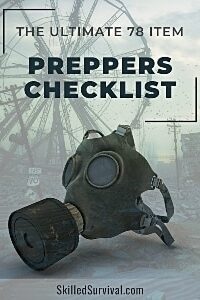
Want a free 78 item preppers checklist?
Enter your email below to instantly download this Complete Checklist PDF. No purchase necessary. 👇 👇What To Do During A Hurricane Watch
A hurricane watch is the first level of forecasting for a hurricane event. This does NOT mean you will see the full effects of the storm. But it means a very real possibility exists in the next few days.
This is the time to consult your list and plan to make any last-minute additions or adjustments.
Listen To The Weather Predictions
A quality hand-crank NOAA weather radio provides critical information from the National Weather Service. Minute-by-minute up-to-date forecasts will keep you advised if conditions change.
This hand crank radio can be charged by plugging it in if you still have access to electricity. You can also charge it with the built-in solar panel or by cranking the generator handle for a few minutes.
In a dire emergency, you can also use the hand crank to charge up your cell phone to make a 1-2 minute call for help.
Double Check Your Critical Supplies
Go through your non-perishable items and replace or restock them if needed. Refill any prescriptions you might need.
If you have kids or pets, some treats, and a new toy or board game might help keep them calm during an evacuation.
Secure Your Property
Bring in any outdoor furniture and equipment, including grills (turn off the propane). Store them safely in a garage or basement if possible. If not, lash them down securely. Close all storm shutters and board up any remaining windows and doors with thick plywood.
Keep Things Cold
If you lose power, it’s best to keep your fridge and freezer as cold as possible. Keep their doors closed, and they’ll remain cool longer even if the power goes out.
Fill Your Gas Tank And Fill Up Gas Cans
Who knows when you’ll find an open gas station while evacuating? So fill up early and consider some extra gas cans for the drive.
We recommend stocking up on fuel for any future emergencies.
If you’ve got a generator, this is a good time to give it a final test. You might also consider investing in a solar generator.
Their prices are starting to come down, and they don’t require any fossil fuels to operate (plus they are completely silent to operate).
What To Do During A Hurricane Warning
When authorities issue a hurricane warning for your area, you should be well ahead of the game. At this point, hopefully, you only have to deal with the last-minute steps.
Keep Listening To Weather Predictions
Keep that NOAA weather radio handy.
Evacuation orders will be broadcast alongside the weather predictions. So make sure you pay attention to the areas affected.
Load Up Your Vehicle
Get your emergency food, supplies, and important documents in the vehicle and ready to go. Consider bringing your laptop and digital copies of all your files. I recommend having a bug-out bag for each family member ready for future emergencies.
So, for a hurricane evacuation, grab your go bags and go!
Review Your Evacuation Routes
Know the whole route, and make sure you also know some alternatives. Traffic jams and weather damage can cause delays or blockages on your primary evacuation route.
Stay Inside And Away From Windows
Even before the worst, damage from flying debris can be dangerous. Resist the temptation to “storm gaze” and avoid all windows and doors.
Shut Off All Utilities
If you’re evacuating, shut down the water and gas lines in case of a leak. However, leave your electricity on to power the fridge and freezer as long as the grid stays up.
Evacuate When Ordered To Do So
If the authorities issue an evacuation order, it’s best to heed it and head for a safer location. Some people try to shelter in place, but that should be a last resort, NEVER your primary plan.
If you can’t leave due to financial limitations or lack of access to a personal vehicle, search for large emergency shelters. Ideally, you want to hunker down in a shelter with a sturdy building and emergency personnel available.
Some stubborn people try to ride out a hurricane in their own homes. I get it.
They’re likely worried about looting during the aftermath. But what are material “things” really worth compared to your life? Zilch…
If the hurricane doesn’t end up being as bad as predicted, you’ll be able to return home quickly. But it’s possible the hurricane could be much worse than predicted.
Don’t be a fool – evacuate or seek authorized emergency shelters.

Want a free 78 item preppers checklist?
Enter your email below to instantly download this Complete Checklist PDF. No purchase necessary. 👇 👇Aftermath Of A Hurricane
After the storm has passed, it’s time to head back and assess the damage. You may find that your home escaped unscathed—or, as my friends did, you may find a bare slab where your house once stood. Either way, keeping your safety in mind as you head back is important.
Don’t Turn Off The Weather Predictions
Keep that NOAA weather radio at hand. Even after the storm has passed, there may be significant rain events and flooding. It could take days or even weeks for everything to clear up.
Wait For An “All Clear” Signal
Officials only lift the evacuation orders when allowing residents back is safe. Again, take that advice.
Drive As Little As Necessary
Random debris will choke roads, making travel difficult. Plus, emergency crews will block roads to restore services quickly. Bridge damage is also possible, and high water may hide washed-out roads.
Thoroughly Inspect Your Home
When it’s safe to enter, inspect your home for damage. Use a camera to document everything for insurance purposes.
Leave The Utilities Off
Avoid turning your gas or water until authorities provide an all-clear. If you’ve got electricity, ensure no downed lines or tree limbs are hanging from the lines. If you see any, immediately report them to the utility company and stay away.
Common Hurricane Misconceptions
As with many disasters and emergencies, there are many misconceptions.
These “myths” can seriously affect your hurricane preparedness. Sure, some of them are harmless. But others can significantly increase your chance of injury or property damage.
Here are some of the most common myths:
1. Tape Your Windows To Prevent Shattering
It turns out that a majority of people surveyed get this wrong. They believe taping windows helps prevent shattering from flying debris. This myth is so widespread you even see it in movies!
People will likely see how the engineered safety glass in automobiles. How it helps hold together the windshield in car crashes using a layer of thin plastic within the glass. They think they can similarly hold the pieces of normal window glass together with tape.
Unfortunately, window glass breaks into large, jagged shards with sharp edges. Edges can easily shred all but the most ambitious tape coverage. If you want to keep your windows safe, skip the tape.
Instead, invest in heavy-duty metal storm shutters or be ready to board up the windows with thick plywood!
2. You Only Need A Few Days Of Medications
If you have prescription medications, don’t count on being able to get a refill after a hurricane. Critical medications are often in short supply immediately after a storm. And many pharmacies are unable to reopen for extended periods due to damage. Especially if the damage was to the medication supplies.
Or there’s a major delay in resupply shipments. An important part of preparing is expecting a reduction in critical supplies. And how long you may need to live without these supplies.
So, ensure you have a few weeks of medications in your emergency kit.
3. Cracking Open Windows And Doors Will Equalize The Pressure
I grew up in “tornado alley,” and this same myth is prevalent there. Many people falsely believe the low pressure in a hurricane or tornado will cause damage. They worry that if the pressure is not quickly equalized, the windows will blow out or the roof will pop up. But no home is airtight.
The pressure differences can easily equalize without leaving doors or windows open. Openings that allow wind, rain, and debris to enter your home!
4. It’s OK To Delay Evacuate Until The Weather Looks Bad
As a hurricane approaches landfall, forecasters work overtime. They analyze heaps of data to pinpoint exactly when and where the conditions will worsen. They use this information to create evacuation orders for the most at-risk areas.
Often, authorities will issue evacuation orders days ahead of actual landfall. Leaving people wondering if they “really” have to leave yet. The problem comes when many people try to evacuate an area at once, taking crowded vehicles, trailers, and all their possessions with them.
The crowds are inevitably slow, and backups form almost immediately. So, instead of quickly leaving the path of destruction, you’re stuck like a sitting duck on the highway. A highway with the hurricane approaching! So don’t wait.
When you hear evacuation orders, load your vehicles, button up your home, and head out ASAP. You’ll be ahead of the game and much more likely to get out of the path of danger without any issues.
5. Tropical Storms Are Not Dangerous Enough To Worry About
The wind speeds might not be as high as a hurricane, but inland flooding due to torrential downpours kills more people. So even if it’s not “technically” called a hurricane – you should take any massive storm seriously.
Hurricane Prep List: Final Thoughts
Hurricanes are a fact of life, and it’s only a matter of time before another major one strikes. Even if it’s been decades since the last one, the future risks are not less. But it creates complacency!
Don’t be a part of the fragile masses who don’t plan ahead. Instead, create a comprehensive list and join the resilient few ready for the next massive hurricane… A lot of careful consideration goes into a hurricane prep list. But you can break it down into manageable chunks and tackle them one at a time.
Even if you only get through a few chunks, you’ll still be ahead of many of your neighbors. Stay safe this hurricane season and every season to come…

Prepare, Adapt & Overcome,
P.s. - I just found out 2 out of 3 Americans don’t feel prepared for a 3 day disaster!!!
I guess this goes to show how modern society continues to embrace ‘living a fragile life.’ What’s crazy is… it’s so easy to fix.
To make sure YOU have the basics, watch our FREE training on “10 Simple Steps To Basic Preparedness” that shows you HOW.
Nothing crazy here… this isn’t doomsday prepping... just the basics every responsible adult should have before a disaster strikes.Why You Can Trust Skilled Survival...
Go here now to review a full breakdown of:
- Who We Are
- Our Credentials
- Our Mission
- & Product Recommendations...
Here are a few highlights of our teams credentials & certifications:
- Certified Member of a Mountain Search & Rescue Organization
- Plant Emergency & Safety Leader for a Major Food Manufacturer
- Member of the 10TH Mountain Division Hut Association
- Certifications: Avalanche 1, WFR, CPR
- Official Gear Tester for Numerous Outdoor Gear Companies
- Countless Multiday Backpacking trips into Remote Wilderness
- Bachelor's Degree In Mechanical Engineering
- Bachelor's Degree In Civil Engineering
- Bachelor's Degree In Biomedical Engineering
"It takes 20 years to build a reputation and five minutes to ruin it." - Warren Buffett
We're fully aware that trust is NOT something you GET but is EARNED.
And we'll continue to earn YOUR trust through our forthright and honest approach with each new Blog Post, Guide & Product we create...
P.s - I just took this FREE 60-second 'Readiness Score Quiz'👇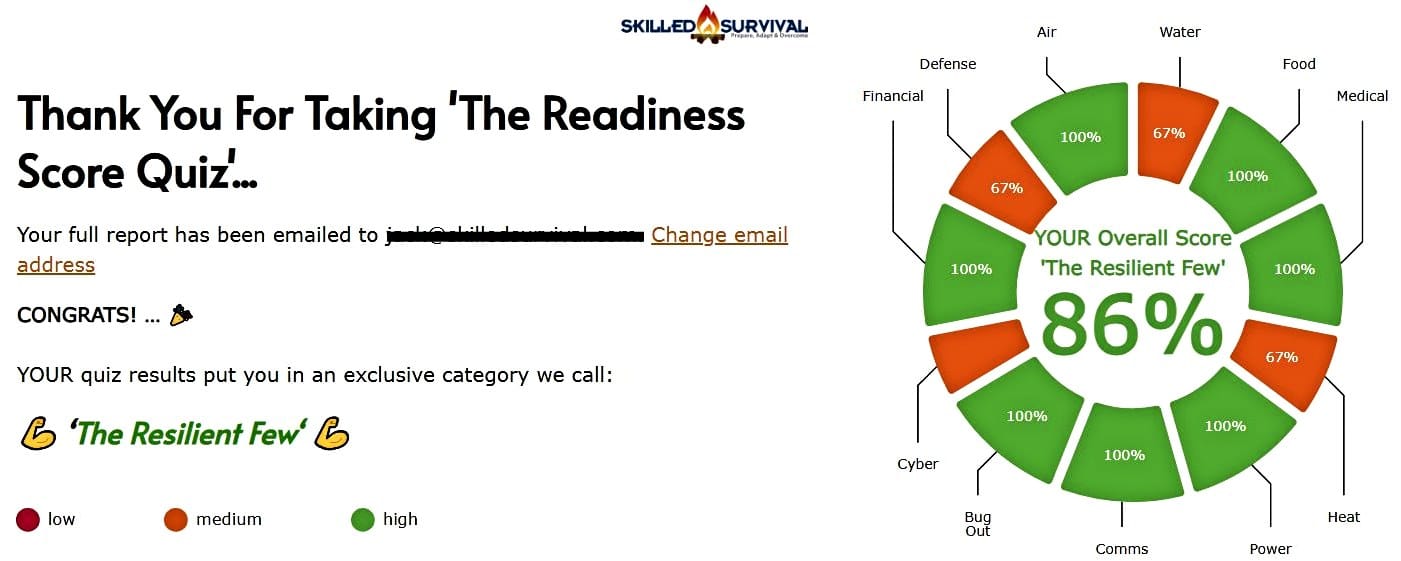
AND... I've still got a few gaps in my preps...🤔 But at least, I'm not part of 'The Fragile Masses'. 👍 Find out where YOU stand by answering a few questions...
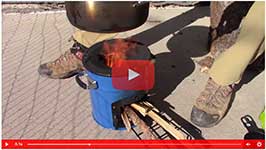
Recommended Reading
Long Term Fuel Storage For Survival Emergencies
Long term fuel storage is crucial in emergencies, but fuels must be stored properly especially long term gasoline storage.
How To Store Seeds For Wise Prepping & Survival
When seed saving and seed storage, you must do it right. Learn how to store seeds so they'll thrive the next planting season.
Common Everyday Carry Mistakes YOU Must Avoid At All Costs
The only person qualified to build YOUR Best Everyday Carry (EDC) is YOU. To do it right, you must avoid these common mistakes and pitfalls.
Strategic Relocation: How To Find A Safe Pace To Live
Use strategic relocation to find a safe, defendable location to call home. Your choice of location WILL determine your survival fate.
Nuclear Fallout Map: Would I Survive A Nuclear Bomb?
Have you seen this nuclear fallout map? Or run a nuclear simulation to see the damage a nuke would do to your city? If not, check this out.
Homestead Survival: How To Master Plan Your Safe Haven
Use this simple 6 homestead survival plan to successfully survive (and thrive) even if the world falls into chaos...
